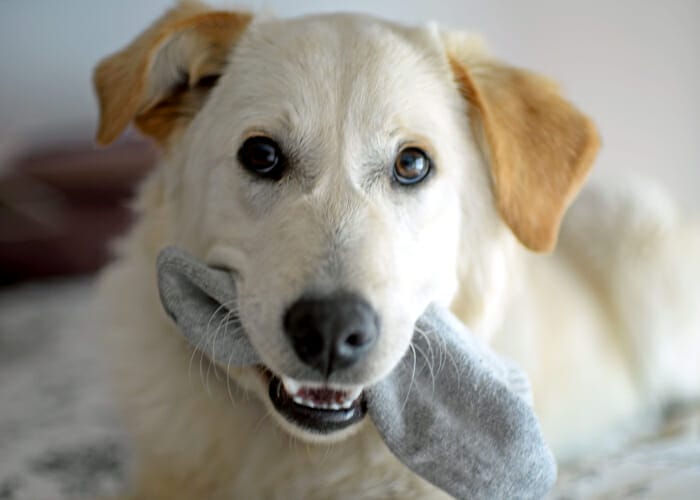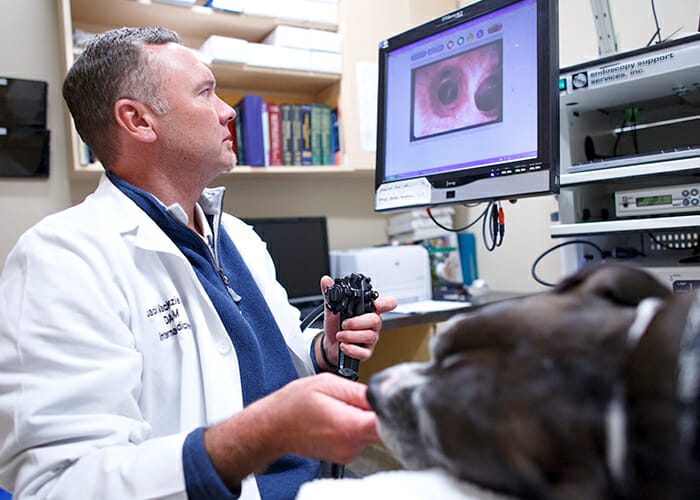Emergency Medicine, Surgery
They Ate What? When Your Pet Swallows a Foreign Object

Dogs and cats love to eat things that they shouldn’t, and fortunately after doing so, they often vomit them up or pass them in their feces. However, this isn’t always the case. Many dogs and cats come to the ER because they are sick from swallowing something they shouldn’t, and the foreign object has gotten stuck in their stomach or intestines. This may not sound alarming but swallowing a foreign object can be deadly. This article discusses what to do when pets swallow things they shouldn’t.
A Quick Look at the Anatomy of Dogs and Cats
When food is eaten, it travels down the esophagus, and makes its way into the stomach, where it is digested. Next, it travels into the intestines to be absorbed, then into the colon, and eventually out the other end through the rectum and anus. It’s easiest to picture this process like a garden hose. Water in the hose starts from the house connection and flows out the nozzle on the other end.
Cats Love String and Ribbons While Dogs Love Just About Any Foreign Object!

Cats mostly eat strings and ribbons. Additionally, long-haired cats often become obstructed from hairballs. On the other hand, most dogs eat just about anything. Our teams have removed crazy objects from dogs – even knives – but often, it’s socks or underwear.
Depending on the object, the gastrointestinal tract can be affected differently, but ultimately, the results are the same: a trip to the emergency room.
- If the object is non-linear, such as a corn cob (which is a very common object to get stuck), then it can get into the small intestines, blocking the flow of the ingesta. This is like plugging the center of a garden hose with an object, such as when you step on it. The garden hose will get more and more dilated as the water continues to flow from the source but is being blocked. When this happens in pets, this can lead to enough pressure on the intestines to cause them to puncture or burst, resulting in leakage of fluid into the abdomen, causing septic peritonitis, which is deadly.
- If the object is linear, such as a string, ribbon, or shredded carpet, one end of the string often gets anchored somewhere in the beginning of the gastrointestinal tract, and the other end continues to travel toward the rectum. This causes the intestines to pleat like an accordion, which can perforate the intestines. In cats, the string is most frequently anchored under the tongue. In dogs, linear objects most commonly anchor in the stomach.
What Goes Down, Must Come Up – and Out
If a pet swallows something they shouldn’t, call your veterinarian. In some scenarios, it is advised to make the pet vomit. However, if the foreign material is confined to the esophagus or stomach, and vomiting is not indicated, it may be able to be removed via endoscopy. Endoscopy is the use a long camera with devices that allow removal of the object without surgery. If neither vomiting nor endoscopy are possible, then surgery is needed.

Moving the Foreign Object
If the object is in the intestines, sometimes a veterinarian can move the object back into the stomach, and then pass endoscopic equipment down the esophagus into the stomach and remove the object without cutting into the stomach organ itself. This removes the concern of healing the gastrointestinal tract, as no incision was made. Other times, the veterinarian can move the foreign body into the colon and rectum. Once a foreign body makes it to the colon, it will pass in the feces. Another approach can be to push the object far down into the rectum, and then reach up and pull it out through the anus. Pets are under anesthesia during these processes, so they do not feel pain.
Surgical Approaches to Remove a Foreign Object
Veterinarians can use several types of surgery to remove foreign objects. If the object is in the stomach, but too large or dangerous to remove with the endoscope, a gastrotomy will be performed. This is an incision into the stomach to remove the object. The stomach is a better-healing organ than the small intestine, and there’s less risk of complications post-surgery.
However, if the object has made its way into the intestines and the object cannot be moved into the stomach, it must be removed from the intestines. This is called an enterotomy. If, however, the foreign body has caused irreversible damage to the intestines where it is located, your pet may need a resection and anastomosis.
The most important risk associated with intestinal surgery is leakage of the surgery site, leading to peritonitis. Peritonitis is a deadly problem with studies showing approximately 50% of dogs and cats surviving. This is why it is best to avoid foreign bodies all together!
If all goes well, your pet will typically spend one to two days in the hospital to ensure they have recovered. When your pet goes home, they must follow two very important rules: two weeks of confinement and rest, and two weeks of wearing an E-collar. This is to ensure the incision heals well with minimal complications.

Four Tips to Preventing Your Pet from Swallowing a Foreign Object
To prevent your pet from swallowing things they shouldn’t, consider the following:
- Discuss proper behavioral training with your veterinarian.
- Make sure everyone in the house is responsible for their belongings. Never leave socks and underwear on the floor, as these are the most common things removed from dogs. In addition, do not leave any form of string-like objects like tinsel and sewing kits around, especially if you have cats.
- Be conscious of where your pet is, and what you have around the house that they could get into. For example, can they get into the garbage can? Onto a counter or into your child’s playroom?
- Keep in mind that unlike humans, pets don’t learn from their mistakes. All they know is they felt sick, and now they don’t. Many pets are “repeat offenders;” some dogs have as many as 14 surgeries in their lifetime. This is dangerous. A basket muzzle may be needed if the behavior cannot be curbed in patients like these.
MedVet is Here to Help
Our pets are clever and curious. This means even with the best prevention, it’s possible your pet will swallow something they shouldn’t. When this occurs, be sure to call your veterinarian right away for guidance. If your family’s veterinarian is unavailable, then contact your nearest MedVet.
A version of this article first appeared in CincyPet Magazine in April 2021.